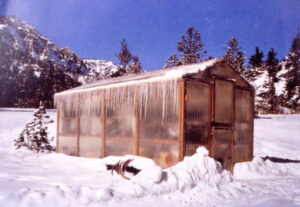In order to find out how to heat your greenhouse, use Heat Calculation Formulas. Heat conservation is first. Seal and insulate where needed.
- Heat only as much as your plants require (this may feel cool to you).
- Reduce heat loss by using a Heat-Saver Fan to pull heat off the ceiling.
- Our Prewired Portable Heater Thermostat will also save heat by accurately turning your 120 volt heater on and off.

How to Calculate Heat Requirements for Your Greenhouse
Proper heating is essential for maintaining a stable and productive growing environment in your greenhouse during the colder months. To avoid under- or over-sizing your heating system, it’s helpful to estimate your greenhouse’s heating requirements in BTUs (British Thermal Units)—a standard unit of heat energy.
The following simple formula provides a baseline estimate:
A × D × 1.1 = BTUs
Where:
-
A = Total surface area of your greenhouse (walls + roof), in square feet
-
D = Temperature difference (°F) between the coldest expected outdoor winter temperature and your desired minimum nighttime temperature inside the greenhouse
-
1.1 = A constant that accounts for average heat loss through greenhouse materials
The result is the number of BTUs per hour your heating system should be capable of providing to maintain the desired internal temperature.
Step-by-Step Example:
Let’s say your greenhouse has:
-
400 sq. ft. of total surface area (walls and roof combined)
-
Your coldest outside winter temperature is 10°F
-
You want to maintain a night temperature of 60°F
D = 60 – 10 = 50°F
BTUs = 400 × 50 × 1.1 = 22,000 BTUs/hour
Adjustment Factors
You can further refine your heating requirement by accounting for insulation and structure type, which reduce heat loss:
-
Subtract 30% from the total BTU requirement if your greenhouse is insulated with double glazing or a polyethylene inner liner, as these materials improve thermal retention.
-
Subtract an additional 30% if your greenhouse is a lean-to style attached to a heated building wall, since this wall contributes additional heat and reduces surface area exposed to the cold.
Using the above example with both adjustments:
-
Start with 22,000 BTUs
-
Subtract 30% for insulation → 22,000 × 0.7 = 15,400 BTUs
-
Subtract another 30% for a heated lean-to wall → 15,400 × 0.7 = 10,780 BTUs/hour
This refined estimate helps ensure you’re not over-spending on a heating system that’s larger than necessary, while still keeping your plants protected from the cold.






